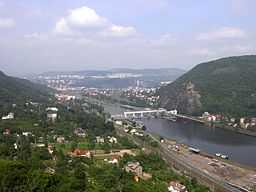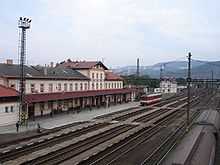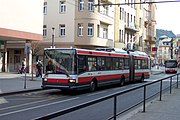Ústí nad Labem
| Ústí nad Labem | |||
| City | |||
 | |||
|
|||
| Country | Czech Republic | ||
|---|---|---|---|
| Region | Ústí nad Labem | ||
| District | Ústí nad Labem | ||
| Commune | Ústí nad Labem | ||
| River | Elbe | ||
| Elevation | 218 m (715 ft) | ||
| Coordinates | 50°39′30″N 14°2′30″E / 50.65833°N 14.04167°ECoordinates: 50°39′30″N 14°2′30″E / 50.65833°N 14.04167°E | ||
| Area | 93.95 km2 (36.27 sq mi) | ||
| - metro | 874 km2 (337 sq mi) | ||
| Population | 95,464 (2010) [1] | ||
| - metro | 243,878 | ||
| First mentioned | 1056 | ||
| Mayor | Josef Zikmund (Since December, 2014) | ||
| Timezone | CET (UTC+1) | ||
| - summer (DST) | CEST (UTC+2) | ||
| Postal code | 400 01 | ||
  Location in the Czech Republic
| |||
 Usti nad Labem
| |||
| Wikimedia Commons: Ústí nad Labem | |||
| Statistics: statnisprava.cz | |||
| Website: www.usti-nl.cz | |||
Ústí nad Labem (Czech pronunciation: [ˈuːsciː ˈnad labɛm]), German: Aussig,[2] is a city of the Czech Republic in its eponymous region. The city is the seventh-most populous in the country. Ústí is situated in a mountainous district at the confluence of the Bílina and Elbe rivers, and, besides being an active river port, is an important railway junction.
Naming
The Old Czech word ustie meant "river-mouth": the name as a whole appears to refer to the river Bilina flowing here into the Elbe (Czech: Labe). The current name means literally "Mouth-upon-the-Elbe". In Latin, the town used the name Usk super Albium. The German name Aussig or Außig is derived from Czech.
History
Ústí nad Labem was mentioned as a trading centre as early as 993. In the latter part of the 13th century King Otakar II of Bohemia invited German settlers into the country and granted them German city law, thereby founding the city. In 1423 Emperor Sigismund of the Holy Roman Empire pledged the town to Elector Frederick I of Meißen, who occupied it with a Saxon garrison. In 1426 it was besieged by the Hussites, who on June 16, 1426, though only 25,000 strong, defeated and slaughtered a German army of 70,000 which had been sent to its relief; the town was stormed and ransacked the next day. After lying derelict for three years, it was rebuilt in 1429. It suffered much during the Thirty Years' War and Seven Years' War.
Until 1918, the town was part of the Austrian monarchy (Austria side after the compromise of 1867), head of the Aussig district, one of the ninety-four Bezirkshauptmannschaften in Bohemia.[3]
During the 19th century the city, known by its German name Aussig, became heavily industrialised. Due to large-scale immigration the number of inhabitants grew from 2,000 to over 40,000, making Ustí one of the biggest cities in Bohemia. Mining, chemical industry and river transport were its most important assets. The local river port became the busiest one in the whole Austro-Hungarian Empire surpassing the seaport in Trieste. Nowadays it is the industrial city with chemical establishments, metallurgy manufacture, machine tool industries, textiles and nutriment industry.
20th century
Ústí was a centre of early German National Socialism. On November 15, 1903, the Deutsche Arbeiterpartei in Österreich ("German Workers' Party in Austria") was formed; it would become the basis for the Sudeten German National Socialist Party and Austrian National Socialism. Much of their literature and books were printed in Ústí.
In 1918 the city became part of Czechoslovakia following the collapse of the Austro-Hungarian Empire. According to the 1930 census there were 43 793 persons living in Ústí nad Labem (32 878 of German ethnicity, 8 735 of Czechoslovak ethnicity, 222 of Jewish ethnicity, 16 of Russian ethnicity and 11 of Hungarian ethnicity).[4] In October 1938 it was ceded, together with the rest of the Sudetenland, to Germany according to the Munich Agreement. The city was severely bombed by the Allies in April 1945. After the World War II the city became again part of restored Czechoslovakia, and most of the German population was later expelled in accordance with the Potsdam Conference and the Beneš decrees.
On New Year's Eve in 1938, the Nazis burnt down the local synagogue, which was converted into a meat factory. While there was a relatively large Jewish community in Ústí nad Labem prior to the war, during the war, the great majority of the town's Jewish residents were sent to Nazi death camps.
-

German occupation, 1939
-

Bomb damage, 1945
-

Holocaust memorial, 2005
Matiční Street Wall
The city gained notoriety in the late 1990s when a 150 metres (490 ft) long wall was constructed along part of the Matiční Street separating houses on one side from the tenement blocks on the other. Since the latter were homes mainly to Romani, it turned into an international scandal. Mayor Ladislav Hruška promised local homeowners' representatives that the wall would be finished by the end of September, 1998. Foreign journalists travelled to Ústí to investigate, and were told by councillors that the wall was not meant to segregate by race, but to keep respectable citizens safe from noise and rubbish coming from the opposite side of the street.[5]
In September, city representatives announced that plans would be changed from a four-metre soundproof wall to a 1.8-metre wall of ceramic bricks, and a children's playground would also be constructed in front of the tenement blocks. Despite these changes, the Roma Civic Initiative and Deputy Prime Minister Vladimír Špidla vocally opposed the construction.[6] The wall was criticised by U.S. Congressman Christopher Smith, and a delegation from the Council of Europe described it as a "racist" and drastic solution.[5]
The new plans slated construction to begin August 30, 1999, but a decision by the district office delayed the move because a wall that large would require a permit, and threatened to damage the root systems of trees along Matični Street. On October 5, however, construction began regardless of the opposition by foreign observers and members of the Czech government. The following day, 50 Roma physically blockaded construction of the wall and dismantled parts that had already been set up.[5] Nonetheless, the wall was completed on October 13. Domestic and international pressure eventually convinced the city to dismantle the wall, and it was demolished six weeks after it had been erected. The local zoo uses parts of this ceramic fence as a wall around its main entrance to this today. The original wall was only 1.8 metres high and a few more rows of ceramic parts were needed to make it higher. Matiční Street is now uninhabited and its buildings are scheduled for demolition.
Tourism
The Střekov castle is located in a southern suburb of the city. Ústí is a centre for tourism owing to the romantic landscape of the Bohemian Highlands (České středohoří) and the České Švýcarsko national park.
-
.jpg)
Panorama from a nearby observation tower
-
Střekov castle, 14th century
-
.jpg)
České Švýcarsko national park
Famous natives and residents
One of the most famous Bohemian artists, the painter Anton Raphael Mengs (1728–1779), was born in Ústí nad Labem. Among the city's other natives are the illustrator and designer Heinz Edelmann (1934–2009) and the writer Vladimír Páral (born 1932).
Modern sports figures born in the city include Milan Hejduk (born 1976), hockey player and former team captain for the Colorado Avalanche; Michal Neuvirth (born 1988), hockey player for the New York Islanders; and Jiří Jarošík (born 1977), association football player, formerly of Chelsea FC and Celtic FC player, currently of Deportivo Alavés.
The composer, conductor and pianist Viktor Ullmann (1898–1944) served for a brief time (1928–1929) as head of the city's opera company. The renowned mathematician Petr Vopěnka spent most of his teaching career at the city's Jan Evangelista Purkyně University.
International relations
Twin towns — Sister cities
Ústí is twinned with:
-
 Halton, United Kingdom
Halton, United Kingdom -
 Chemnitz, Germany
Chemnitz, Germany -
 Vladimir, Russia
Vladimir, Russia
Transportation
Road transportation
The city is connected to the international highway E 442 (Liberec, Děčín, Ústí, Dresden) and first class highways (I/8, I/30, I/13). It is also directly connected to the express highway D8 (Berlin – Prague) that intersects the western border of the city. Some sections of the highway are already in operation, with the completion of the entire highway in Czech territory currently planned for 2016.
City mass transportation
The city has a network of mass transportation that includes bus and trolley bus lines.
Railway transportation
Usti nad Labem is an important railway node with four railway stations that is intersected by international lines Berlin-Vienna and Berlin-Budapest-Beograd-Sofia (Baltic-Orient). The backbone international line is the national railway line No. 090 – I. transit railway corridor State frontier Decin – Usti nad Labem – Prague – Breclav – state frontier which is part of the IV. Trans-European Multimodal Corridor. The re-construction on the way and the modernisation of the line to meet the parameters of increased line speed will add quality to personal and commercial transportation. On the line section that intersects the city centre interregional railway transportation, suburban transportation and the backbone city mass transportation will come together. The Eurocity (EC) and Intercity (IC) trains connected to the European railway network stop regularly in Usti nad Labem Central Station.
River transportation
The Elbe River Line is a junction with the West-European river lines opening access to Germany, Benelux countries, northern France and to important sea ports. The Elbe River Line is a part of the IV. Trans-European Multimodal Corridor. Freight transportation and pleasure cruises are run on the water line section Pardubice – Chvaletice – Usti nad Labem – Hřensko – Hamburg.
Air transportation
Currently, an airport for small sports planes is under construction. The nearest airport for airliners is in Prague (92 km) or Dresden, Germany (75 km).
Mariansky Bridge
Mariansky Bridge was opened in 1998. The road bridge over the Elbe was built over a period of five years. The city has invested over CZK 750 million ($37,500,000) to build it. The bridge won an award of the European Association of Steel Structures - ECCS (European Convention for constructional Steelwork) European Steel Design Awards. International Association for Bridges and Civil Engineering ranked Mariansky Bridge between the 10 best structures of the world for the last decade.
-

City centre
-

Railway station
-
Municipal trolleybus
-

Ústí n ad Labem - main railway station
-
.jpg)
Mariansky Bridge
References
- ↑ Larger urban zone, Eurostat 2003
- ↑ "Aussig" in the Encyclopædia Britannica, 9th ed. 1878.
- ↑ Die postalischen Abstempelungen auf den österreichischen Postwertzeichen-Ausgaben 1867, 1883 und 1890, Wilhelm KLEIN, 1967
- ↑ Encyklopedie branné moci Republiky Československé, Fidler, Sluka, 2006
- ↑ 5.0 5.1 5.2 Usti nad Labem / Maticni Street romove.radio.cz, 26-02-2000
- ↑ Hiding Gypsies behind a wall, BBC, February 26, 1999
-
 This article incorporates text from a publication now in the public domain: Chisholm, Hugh, ed. (1911). Encyclopædia Britannica (11th ed.). Cambridge University Press.
This article incorporates text from a publication now in the public domain: Chisholm, Hugh, ed. (1911). Encyclopædia Britannica (11th ed.). Cambridge University Press.
External links
| Wikimedia Commons has media related to Ústí nad Labem. |



